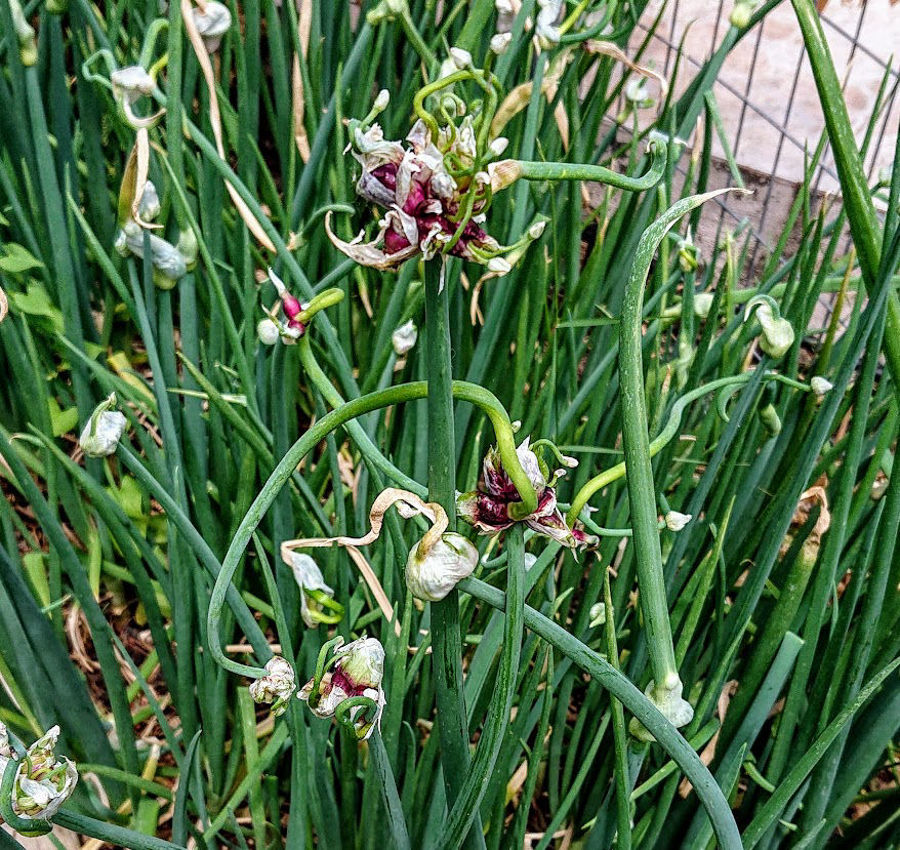
These little darlings have several names. Walking Onions, Egyptian Walking Onions, Tree Onions, Topsetting Onions, or as we call them in Swedish - “Air Onions”. The scientific name is Allium × proliferum. And yes, they sure are very prolific, as the name tells!
Our specific strain of Walking Onions came from Norway in the 1950s and has since then traveled from person to person. I received a few bulbils as a gift from a gardening friend several years ago. I now replant them every year. They are easily propagated, just break off the bulbils and plant them in the garden!
They of course grow in the ground like any other onion. But instead of setting flowers that produce seeds, they produce a cluster of topset onions. In a natural stage these topset onions then “walk”, or more correctly, they fall over and then replant themselves a bit away from the ground onion. They are very cold hardy and become perennial. Planted ones in your garden you will have onions for the rest of your life.
The life cycle of the Walking Onion starts in the spring when the fresh new leaves sprout like little green spikes. The blue-green-grey leaves are hollow and round and very tasty! The leaves are the solar panels of the onion and gather energy for the onions that will start to grow on both sides of the plant. A part of the leaves can be harvested and used as chives, but don’t collect all.
During the season the ground onions then grow like any onion. The leaves will make way for a dominant stalk that can get quite high, around 50cm. On the top of the stalk, a cluster of bulbils will start to grow. First, they are enclosed in a papery-looking bag. These are the topset onions. Later in the season the “paper bag” will tear open, revealing the topsets, looking just like tiny, regular onions.
The topsets will also start to sprout leaves of their own. They are already complete plants in their own and can be planted directly. Each stalk can produce as few as 2 topsets or as many as 30 topsets per stalk. Some topset onions will also sprout a stalk of their own, producing a smaller cluster of topset onions. At the end of the season, the ground onions will be the size of a smaller shallot-like onion.
Depending on your region and climate the Walking Onion might not produce topset onions in the first season. This also depends on the size of the topsets, if ground onions were planted, etc. Basically, the bigger onion/topset planted, the more energy is stored in the onion. And the better the chances are that new topsets will be produced.
How to plant and care for your Walking Onions:
- Plant your topset onions about 3-5cm deep. Space between the rows should be around 20-30cm, approximately.
- Best if the soil is quite well drained, onions in regular don’t like “wet feet”. Walking Onions however are very hardy, also when it comes to wet soil.
- Plant in full sun. Depending on you growing conditions partial shade is also ok.
- Topset onions can be planted in clusters. Larger onions is best planted a bit apart.
- Can be planted any time of year. Of course, depending on your own conditions. It is quite hard, after all, to plant when there is snow and the soil is frozen. The best time to plant might be in the fall. Then they will have time to develop a nice root system for optimal growth in the following spring.
- The topsets can also be planted in pots, to grow indoors or outdoors.
How to use your Walking Onions:
- Use the fresh leaves as chives in the spring.
- Use the shallot-like onions that grow in the ground as regular onions for cooking.
- The topset onions can be used as regular onions for cooking. They can also be pickled/canned and stored for later use or eaten raw. They are quite strong in flavor.
- The whole plant is edible, onions, leaves, and bulbils.
- If you want to store your onions or topsets you need to store them in cold, dark and dry conditions.


